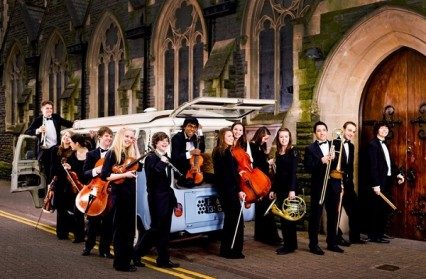Peter Reynolds was at Hereford Cathedral to review a performance by the National Youth Orchestra of Wales with guest conductor Paul Daniel.
Let’s be clear about one thing: any assessment of a youth orchestra’s performance of Stravinsky’s The Rite Of Spring has to acknowledge that such a band, as in the case of the National Youth Orchestra of Wales – the ‘Nash’ – meets briefly once a year for strenuous rehearsals and a short but punishing series of concerts in which is performed what has been learned. OK, two things: however talented the orchestra, however inspiring its conductor and however much its annual experience might not be considered exhausting at all, but actually an exhilarating joyride, it is never going to match the Berlin Philharmonic or the Chicago Symphony or even a second division band of professionals. That said, it’s a truism that forty years ago, the Nash wouldn’t have played this kind of music in public or at this high standard. At the very least, that says a lot for music tuition in state schools, which, of course, is being decimated everywhere. Draw what conclusions you will. This concert, apart from anything else, was thus an example of increasing orchestral proficiency among the young, which is what stands to be lost unless we are vigilant and demanding.
But one shouldn’t over-state the case for difficulty and achievement. Not that long ago, the reluctance of professional orchestras to tackle the Stravinsky work, let alone anything else of iconoclastic stature, was down to their conservatism and the timidity of conductors otherwise full of bluster. Now, it’s considered almost routine, and it holds few terrors, even for the young. Though archivists cannot be absolutely sure, they believe this is the first time the work has been performed by the Nash. The orchestra and guest conductor, Paul Daniel, went for broke in choosing a programme in which the brassy quotient was high, so that by the time Stravinsky was reached via Paul Dukas and Floren Schmitt, the stage was set. Not least of the winning ways was the orchestra’s ability to emerge from the relatively dense scoring of the French composers to Stravinsky’s often violent transparency. The roominess of the score was, sadly, not a condition reflected on the platform, where Hereford’s cheek-by-jowl arrangements, as on other occasions, forced the kitchen department into the north aisle, and the harpists and rear first-violin desks into the south. Not to see as well as hear the percussion in The Rite of Spring was to be short changed.
On this occasion, the 300th anniversary of the Three Choirs Festival, theirs wasn’t so much an interpretation as an exercise in nailing the basics, especially maintaining the consistent throb, real or imagined, that ensures we are aware of the work as a procession leading to a cathartic terminus, with outbursts that don’t sound as if the musicians were just waiting for the opportunity to explode. One wouldn’t have wanted cartharsis on route. What passes for longueurs in the work, transparency at its most clear, exposes the winds; in this case mostly to their credit, but with some momentary fudging in places. Rhythmically, though, the performance was crisp, the tempo finely judged. As Stravinsky himself described it, the music of The Rite swells, enlarges and expands, something Paul Daniel heeded throughout to establish and maintain the music’s constant feverishness. This was an occasion on which conductor and orchestra needed to believe in each other, and there was plenty of evidence for that. No conductor could have been more conspicuous and panoramic in his direction, no youth orchestra more willing to deliver what he wanted to the best of its ability.
Ancient cathedrals were not meant to accommodate music to illustrate a pagan rite or, in Schmitt’s La Tragédie de Salomé, sympathy for a debauchee (Gloucester’s refusal to countenance the music of Delius until comparatively recent times is something too embarrassing to resurrect), but it was not the more liberal atmosphere that prevailed here as much as the devilish acoustics for an orchestra required to deal with both declamation and close textures, some of which in the latter case were too close for aural comfort. But as a rounded piece it was magnificent. What you heard in this work and in Dukas’s shimmering narrative, where the same reservations obtained but slightly less so in the double sequence of variations, probably depended on where you were sitting, and that applied to members of the band as well as the audience.
No-one, however, could mistake the forthright brass section in the fanfare at the start of La Péri, which was as much composer’s afterthought as statement of Welsh intent. The Nash’s 2015 programme will sound different in each of its venues – it played Bangor and Aberyswyth before travelling to Hereford – but none will militate against the orchestra’s musicianly poise and conviction. It stands proud before a 65-year-old history. The Nash was, after all, the world’s first youth orchestra.
* Futher evening appearances with the same programme and day programmes featuring young composers as follows:
Theatr y Ffwrnes, Llanelli, July 31, 12.30pm (NYOW Young Composers)
Theatr y Ffwrnes, Llanelli, July 31, 7.30pm
St David’s Hall, Cardiff, August 1, 1pm (NYOW Young Composers)
St David’s Hall, Cardiff, August 1, 7.30pm
Photo from National Youth Orchestra of Wales: Facebook.com/NYOWTheNash
Hereford Cathedral, July 30 2015*
National Youth Orchestra of Wales
Conductor: Paul Daniel
Dukas: La Péri
Schmitt: La Tragédie de Salomé
Stravinsky: The Rite of Spring
Recommended for you:
Nigel Jarrett witnesses the powerful and moving conclusion of Welsh National Opera Youth Opera’s Freedom Summer Season with Brundibar by Hans Krása.



 Enjoyed this article? Support our writers directly by buying them a coffee and clicking this link.
Enjoyed this article? Support our writers directly by buying them a coffee and clicking this link.







